Themed collection Scanning probe frontiers in molecular 2D-architecture world

Probing functional self-assembled molecular architectures with solution/solid scanning tunnelling microscopy
STM is emerging as a tool to elucidate and guide the use of self-assembled molecular systems in practical applications, including small molecule device engineering, molecular recognition and sensing and electronic modification of 2D materials.
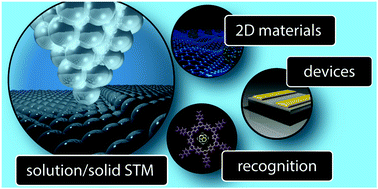
Chem. Commun., 2018,54, 10527-10539
https://doi.org/10.1039/C8CC04341H
Copper-oxide tip functionalization for submolecular atomic force microscopy
Tip deflection effects in AFM: DBTH molecule imaged with a flexible CO-, and a more rigid O-terminated Cu tip.
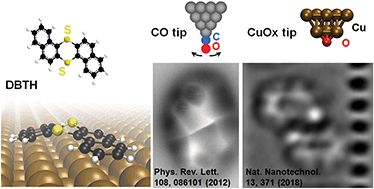
Chem. Commun., 2018,54, 9874-9888
https://doi.org/10.1039/C8CC05332D
Two-dimensional self-assembled nanostructures of nucleobases and their related derivatives on Au(111)
Two-dimensional self-assembled nanostructures can be constructed by nucleobases and various reactants on Au(111).
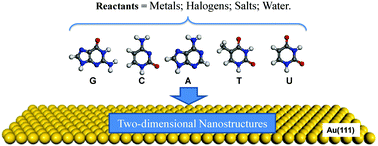
Chem. Commun., 2018,54, 9259-9269
https://doi.org/10.1039/C8CC03585G
Electronic effects and fundamental physics studied in molecular interfaces
Scanning probe instruments in conjunction with a very low temperature environment have revolutionized the ability of building, functionalizing, and analysing two dimensional interfaces in the last twenty years.
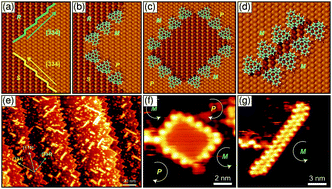
Chem. Commun., 2018,54, 5508-5517
https://doi.org/10.1039/C8CC02191K
Diverse supramolecular structures self-assembled by a simple aryl chloride on Ag(111) and Cu(111)
Diverse self-assembled structures were obtained on Cu(111) and Ag(111) surfaces by using a simple and small 4,4′′-dichloro-1,1′:4′,1′′-terphenyl molecule.

Chem. Commun., 2018,54, 13670-13673
https://doi.org/10.1039/C8CC08673G
From 1D ordered linear polymers to discrete macrocycles: surface adsorption and pH take control
In this work we demonstrate that the surface adsorption and pH play a determining role in controlling the final product of a Schiff base reaction.
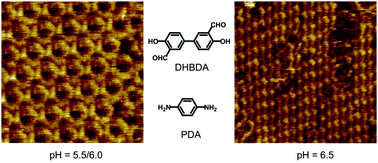
Chem. Commun., 2018,54, 12210-12213
https://doi.org/10.1039/C8CC06036C
The growth and fluorescence of phthalocyanine monolayers, thin films and multilayers on hexagonal boron nitride
Free-base phthalocyanine forms distinct interfacial phases and thin films on hexagonal boron nitride including a monolayer arrangement as determined using high resolution atomic force microscopy.
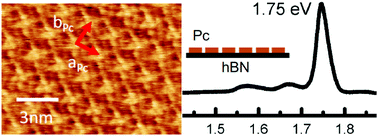
Chem. Commun., 2018,54, 12021-12024
https://doi.org/10.1039/C8CC06304D
Edge-on adsorption of multi-chain functional alkanes stabilizes noncovalent monolayers on MoS2
Diyne phospholipids adsorb edge-on on MoS2, producing stable monolayers with large, ordered domains, despite low alkane adsorption enthalpies on MoS2.

Chem. Commun., 2018,54, 11709-11712
https://doi.org/10.1039/C8CC06466K
Binary supramolecular networks of bridged triphenylamines with different substituents and identical scaffolds
Based on scanning tunneling microscopy experiments combined with density functional theory, we report the formation and the electronic structure of porous binary supramolecular networks on Au(111).
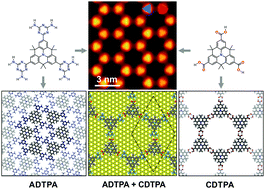
Chem. Commun., 2018,54, 11554-11557
https://doi.org/10.1039/C8CC04410D
Phase separation and selective guest–host binding in multi-component supramolecular self-assembly on Au(111)
We find a phase separation and selective guest–host inclusion in the self-assembly of trimesic acid, benzenetribenzoic acid and coronene on Au(111).

Chem. Commun., 2018,54, 10570-10573
https://doi.org/10.1039/C8CC04491K
Supramolecular nanopatterns of H-shaped molecules
H-shaped arylene–alkynylene scaffolds form brick-like patterns on graphite, as shown via scanning-tunneling microscopy.
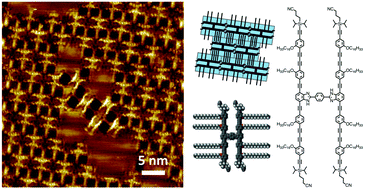
Chem. Commun., 2018,54, 10558-10561
https://doi.org/10.1039/C8CC04403A
On-surface synthesis of heptacene on Ag(001) from brominated and non-brominated tetrahydroheptacene precursors
Achieving the Ag(001)-supported synthesis of heptacene from two related reactants reveals the effect of the presence of Br atoms on the reaction process.

Chem. Commun., 2018,54, 10260-10263
https://doi.org/10.1039/C8CC04402C
Building a 22-ring nanographene by combining in-solution and on-surface syntheses
A nanographene formed by the fusion of 22 benzene rings has been prepared by combining in-solution cycloaddition reactions and on-surface cyclodehydrogenations.
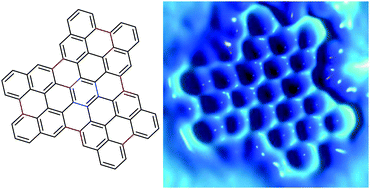
Chem. Commun., 2018,54, 10256-10259
https://doi.org/10.1039/C8CC05353G
Dynamically resolved self-assembly of S-layer proteins on solid surfaces
Kinetic pathway in S-layer self-assembly at the solid–liquid interface across time (second to hours) and spatial scales (nm to microns).
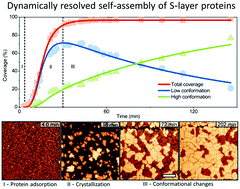
Chem. Commun., 2018,54, 10264-10267
https://doi.org/10.1039/C8CC04597F
The self-assembly and metal adatom coordination of a linear bis-tetrazole ligand on Ag(111)
A rich spectrum of room-temperature stable Ag and Fe2+ coordination nodes, ranging from monomers to trimers, emerges on silver.
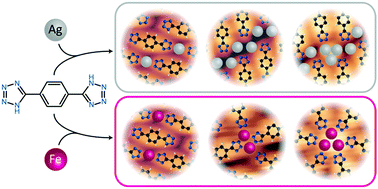
Chem. Commun., 2018,54, 10072-10075
https://doi.org/10.1039/C8CC04323J
Probing the in-air growth of large area of 3D functional structures into a 2D supramolecular nanoporous network
2D host–guest chemistry combined with drop-casting allows to trap functionalized 3D Zn–phthalocyanine complex into a large 2D porous supramolecular template.
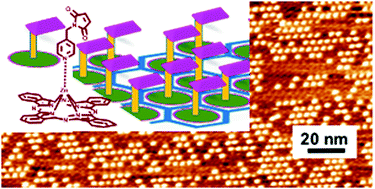
Chem. Commun., 2018,54, 10068-10071
https://doi.org/10.1039/C8CC06125D
Amphiphile self-assembly dynamics at the solution-solid interface reveal asymmetry in head/tail desorption
Asymmetric dynamics in fundamental adsorption and desorption steps drive self-assembly at solution/solid interface.
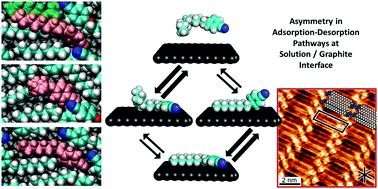
Chem. Commun., 2018,54, 10076-10079
https://doi.org/10.1039/C8CC04465A
The impact of grafted surface defects on the on-surface Schiff-base chemistry at the solid–liquid interface
We investigate the effect of covalently modified graphitic surfaces on the formation of single-layer covalent organic frameworks (sCOFs) at the solid–liquid interface.
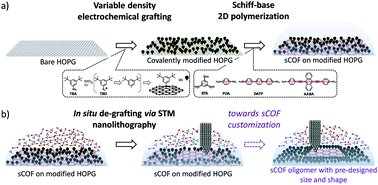
Chem. Commun., 2018,54, 9905-9908
https://doi.org/10.1039/C8CC03867H
The influence of ortho-methyl substitution in organometallic self-assembly – a comparative study on Cu(111) vs. Ag(111)
Steric hindrance by ortho-methyl substitution improves the structural quality of organometallic networks.
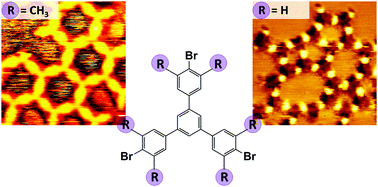
Chem. Commun., 2018,54, 9745-9748
https://doi.org/10.1039/C8CC04854A
Organometallic ring vs. chain formation beyond kinetic control: steering their equilibrium in two-dimensional confinement
Two-dimensional confinement enables thermodynamic control over the competition between macrocycle and chain formation.
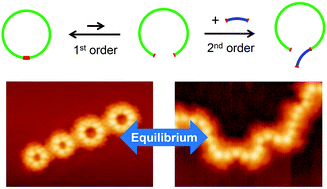
Chem. Commun., 2018,54, 9741-9744
https://doi.org/10.1039/C8CC05357J
Electronic effects of the Bernal stacking of graphite on self-assembled aromatic adsorbates
We show the influence of the material beneath the single atomic layer of graphene on the electronic properties of adsorbed aromatic molecules.
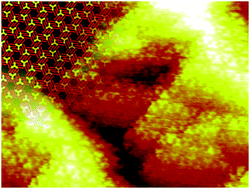
Chem. Commun., 2018,54, 9607-9610
https://doi.org/10.1039/C8CC05806G
On-surface synthesis of superlattice arrays of ultra-long graphene nanoribbons
We report the on-surface synthesis of graphene nanoribbon superlattice arrays directed by the herringbone reconstruction of the Au(111) surface.
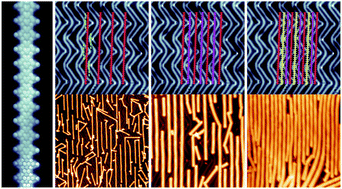
Chem. Commun., 2018,54, 9402-9405
https://doi.org/10.1039/C8CC04830D
Substrate involvement in dioxygen bond dissociation catalysed by iron phthalocyanine supported on Ag(100)
The first evidence is provided of the role played by the metal support in the oxygen reduction reaction catalysed by Ag(100)-adsorbed iron phthalocyanine molecules.
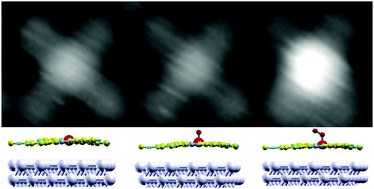
Chem. Commun., 2018,54, 9418-9421
https://doi.org/10.1039/C8CC04362K
Chemistry of 4-[(4-bromophenyl)ethynyl]pyridine at metal surfaces studied by STM
The DFT optimized 44BEP on metal (M) surfaces. The change of binding energy (Eb) and distances (dBr_sub and dN_sub) on different surfaces will bring different configurations and self-assembling behaviours.
![Graphical abstract: Chemistry of 4-[(4-bromophenyl)ethynyl]pyridine at metal surfaces studied by STM](/en/Image/Get?imageInfo.ImageType=GA&imageInfo.ImageIdentifier.ManuscriptID=C8CC03986K&imageInfo.ImageIdentifier.Year=2018)
Chem. Commun., 2018,54, 9305-9308
https://doi.org/10.1039/C8CC03986K
Controlled growth of a bicomponent supramolecular network by the sergeants & soldiers principle
The growth of a bicomponent supramolecular network is controlled by Halogen bonding on a silicon surface and investigated by scanning tunnelling microscopy.
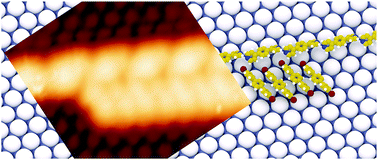
Chem. Commun., 2018,54, 9171-9173
https://doi.org/10.1039/C8CC04226H
Three-dimensional hydrogen bonding between Landers and planar molecules facilitated by electrostatic interactions with Ni adatoms
Ni adatoms are at the origin of a self-assembled bicomponent molecular system on Au(111).
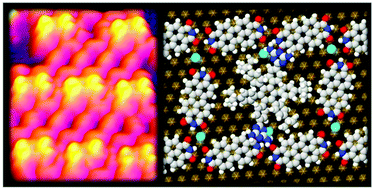
Chem. Commun., 2018,54, 8845-8848
https://doi.org/10.1039/C8CC04247K
Diastereoselective self-assembly of bisheptahelicene on Cu(111)
Diastereospecific two-dimensional crystallization is reported for bishelicenes on a Cu(111) surface.
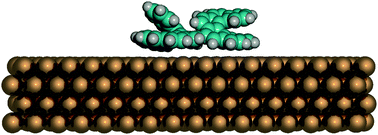
Chem. Commun., 2018,54, 8757-8760
https://doi.org/10.1039/C8CC04160A
Self-assembly of conformationally flexible molecules under 2D confinement: structural analysis from computer simulations
Monte Carlo simulations reveal the role of surface conformers in self-assembly on crystalline supports.
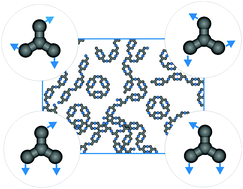
Chem. Commun., 2018,54, 8749-8752
https://doi.org/10.1039/C8CC04272A
Molecular adaptation in supramolecular self-assembly: brickwall-type phases of indacene-tetrone on silver surfaces
Different contrasts are observed via STM in brickwall phases of indacene-tetrone resulting from the adaptation on different epitaxial templates.
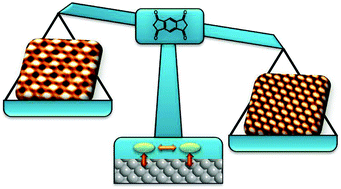
Chem. Commun., 2018,54, 8510-8513
https://doi.org/10.1039/C8CC04883E
Periodic and nonperiodic chiral self-assembled networks from 1,3,5-benzenetricarboxylic acid on Ag(111)
An activated reaction can lead to a diversity of intermolecular bonding motifs through partially-reacted molecules.
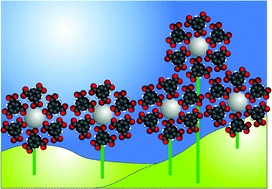
Chem. Commun., 2018,54, 8316-8319
https://doi.org/10.1039/C8CC04380A
Reactive two-component monolayers template bottom-up assembly of nanoparticle arrays on HOPG
Two triphenyleneethynylene derivatives, 1OH and 2, self-assemble a patterned monolayer (ML) at the solution–graphite (HOPG) interface. The monolayer is used to template bottom-up self-assembly of a 5 nm/19 nm double pitch pattern of gold nanoparticles on HOPG.
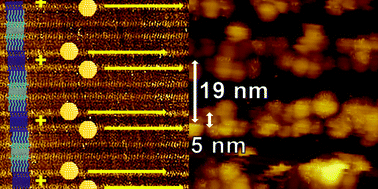
Chem. Commun., 2018,54, 8056-8059
https://doi.org/10.1039/C8CC04058C
Directed assembly of fullerene on modified Au(111) electrodes
Here we show a conceptual approach to realize the scanning tunneling microscopy based induced-assembly of fullerene (C60) molecules on top of a buffer organic adlayer at room temperature in a solution environment.
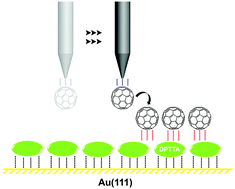
Chem. Commun., 2018,54, 8052-8055
https://doi.org/10.1039/C8CC04284E
Superstructure manipulation and electronic measurement of monolayers comprising discotic liquid crystals with intrinsic dipole moment using STM/STS
In this work, we studied the discotic liquid crystals (DLCs) of dibenzo[a,c]phenazine at the liquid–solid interface using scanning tunnelling microscopy/spectroscopy, by which we show how to tailor the DLC assemblies and in turn their electron-transfer efficiency.
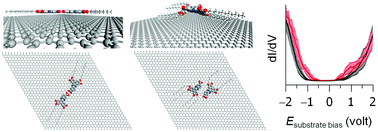
Chem. Commun., 2018,54, 8048-8051
https://doi.org/10.1039/C8CC04241A
Spontaneous separation of on-surface synthesized tris-helicenes into two-dimensional homochiral domains
The on-surface Ullmann coupling of 2,3-dibromo[4]helicene molecules is studied on Au(111) and Cu(111) surfaces.
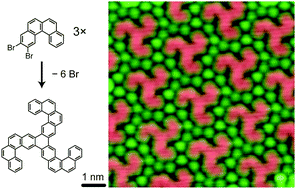
Chem. Commun., 2018,54, 7948-7951
https://doi.org/10.1039/C8CC04235G
Construction of molecular regular tessellations on a Cu(111) surface
Through thermal treatment, three regular molecular tessellations are constructed on Cu(111) with a linear DOD precursor.
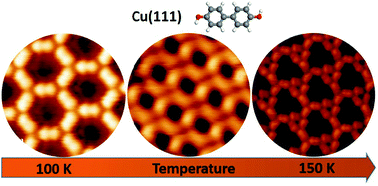
Chem. Commun., 2018,54, 7010-7013
https://doi.org/10.1039/C8CC01719K
Self-assembly and ring-opening metathesis polymerization of cyclic conjugated molecules on highly ordered pyrolytic graphite
We report the STM and AFM images of cyclophane trienes and their ROMP products, presenting unique surface morphologies on HOPG.
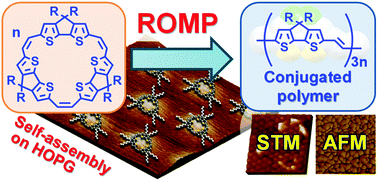
Chem. Commun., 2018,54, 5546-5549
https://doi.org/10.1039/C8CC02224K
On-surface synthesis of a 2D boroxine framework: a route to a novel 2D material?
The synthesis of a 2D boroxine covalent framework is described, which exhibits promising morphological and electronic properties.
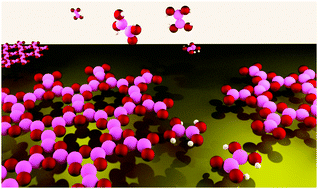
Chem. Commun., 2018,54, 3971-3973
https://doi.org/10.1039/C8CC01372A
On-surface synthesis of polyethylenedioxythiophene
On-surface synthesis of conjugated polymers is made challenging by the need to promote the desired reaction while preventing or minimizing unwanted ancillary reactions that compromise the product integrity.

Chem. Commun., 2018,54, 3723-3726
https://doi.org/10.1039/C8CC01465E
Real-space evidence of Watson–Crick and Hoogsteen adenine–uracil base pairs on Au(111)
The real-space evidence of Watson–Crick and Hoogsteen Adenine–uracil base pairs on Au(111).
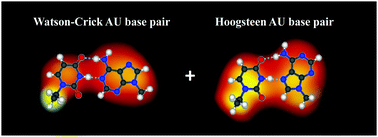
Chem. Commun., 2018,54, 3715-3718
https://doi.org/10.1039/C8CC01134F
Electronic characterization of silicon intercalated chevron graphene nanoribbons on Au(111)
The intrinsic electronic structure of chevron graphene nanoribbons are revealed through in situ silicon intercalation.
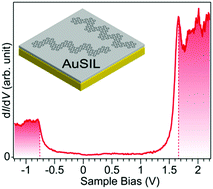
Chem. Commun., 2018,54, 1619-1622
https://doi.org/10.1039/C7CC08353J
Scission and stitching of adenine structures by water molecules
We display the dynamic hydration process of adenine molecular networks by the use of water molecules on Au(111) in real space.
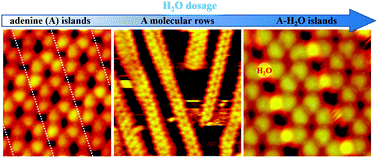
Chem. Commun., 2018,54, 771-774
https://doi.org/10.1039/C7CC09086B
About this collection
Welcome to the ChemComm collection on Scanning probe frontiers in molecular 2D-architecture world, developed to complement the EMRS Symposium of the same name. This collection has been Guest Edited by Professors Alain Rochefort, Frederic Cherioux, Steven De Feyter and Xavier Bouju. It focuses on all aspects of scanning probe microscopy, including both experimental and theoretical work. New articles will be added as they are available.